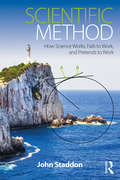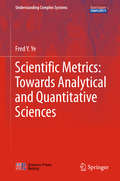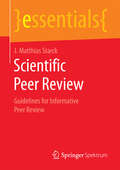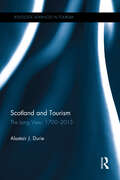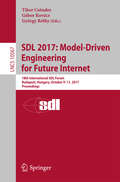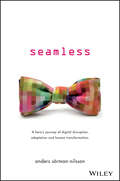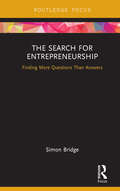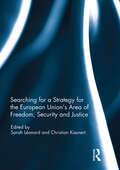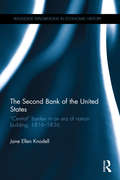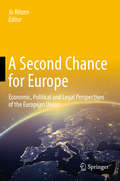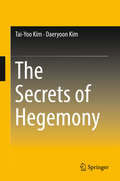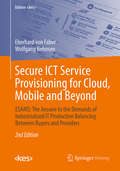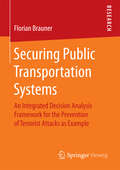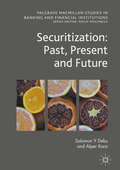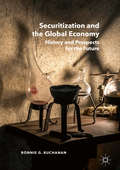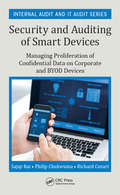- Table View
- List View
Scientific Method: How Science Works, Fails to Work, and Pretends to Work
by John StaddonThis book shows how science works, fails to work, or pretends to work, by looking at examples from such diverse fields as physics, biomedicine, psychology, and economics. Social science affects our lives every day through the predictions of experts and the rules and regulations they devise. Sciences like economics, sociology and health are subject to more ‘operating limitations’ than classical fields like physics or chemistry or biology. Yet, their methods and results must also be judged according to the same scientific standards. Every literate citizen should understand these standards and be able to tell the difference between good science and bad. Scientific Method enables readers to develop a critical, informed view of scientific practice by discussing concrete examples of how real scientists have approached the problems of their fields. It is ideal for students and professionals trying to make sense of the role of science in society, and of the meaning, value, and limitations of scientific methodology in the social sciences.
Scientific Method: How Science Works, Fails to Work, and Pretends to Work
by John StaddonThis book shows how science works, fails to work, or pretends to work, by looking at examples from such diverse fields as physics, biomedicine, psychology, and economics. Social science affects our lives every day through the predictions of experts and the rules and regulations they devise. Sciences like economics, sociology and health are subject to more ‘operating limitations’ than classical fields like physics or chemistry or biology. Yet, their methods and results must also be judged according to the same scientific standards. Every literate citizen should understand these standards and be able to tell the difference between good science and bad. Scientific Method enables readers to develop a critical, informed view of scientific practice by discussing concrete examples of how real scientists have approached the problems of their fields. It is ideal for students and professionals trying to make sense of the role of science in society, and of the meaning, value, and limitations of scientific methodology in the social sciences.
Scientific Metrics: Towards Analytical And Quantitative Sciences (Understanding Complex Systems)
by Fred Y. YeThis book presents scientific metrics and its applications for approaching scientific findings in the field of Physics, Economics and Scientometrics. Based on a collection of the author’s publications in these fields, the book reveals the profound links between the measures and the findings in the natural laws, from micro-particles to macro-cosmos, in the economic rules of human society, and in the core knowledge among mass information. With this book the readers can gain insights or ideas on addressing the questions of how to measure the physical world, economics process and human knowledge, from the perspective of scientific metrics. The book is also useful to scientists, particularly to specialists in physics, economics and scientometrics, for promoting and stimulating their creative ideas based on scientific metrics.
Scientific Peer Review: Guidelines for Informative Peer Review (essentials)
by J. Matthias StarckJ. Matthias Starck comprehensively guides the reader in this essential through all steps of writing an expert review for a scientific journal. It is built on a succinct analysis how science works, how science is communicated and how science is published. It provides a critical guide how to write good, informative and fair peer reviews. The author presents a critical discussion of different peer review procedures and their alternatives, explains ethical guidelines as well as the dark sides of scientific publishing. So this essential helps the reader to perform better in the existing system and to contribute to its further development and improvement.
Scotland and Tourism: The Long View, 1700–2015 (Routledge Advances in Tourism)
by Alastair J. DurieTourism has long been important to Scotland. It has become all the more significant as the financial sector has faltered and other mainstays are in apparent long-term decline. Yet there is no assessment of this industry and its place over the long run, no one account of what it has meant to previous generations and continues to mean to the present one, of what led to growth or what indeed has led people of late to look elsewhere. This book brings together work from many periods and perspectives. It draws on a wide range of source material, academic and non-academic, from local studies and general analyses, visitors’ accounts, hotel records, newspaper and journal commentaries, photographs and even cartoons. It reviews arguments over the cultural and economic impact of tourism, and retrieves the experience of the visited, of the host communities as well as the visitors. It questions some of the orthodoxies – that Scott made Scott-land, or that it was charter air flights that pulled the rug from under the mass market – and sheds light on what in the Scottish package appealed, and what did not, and to whom; how provision changed, or failed to change; and what marketing strategies may have achieved. It charts changes in accommodation, from inn to hotel, holiday camp, caravanning and timeshare. The role of transport is a central feature: that of the steamship and the railway in opening up Scotland, and later of motor transport in reshaping patterns of holidaymaking. Throughout there is an emphasis on the comparative: asking what was distinctive about the forms and nature of tourism in Scotland as against competing destinations elsewhere in the UK and Europe. It concludes by reflecting on whether Scotland's past can inform the making and shaping of tourism policy and what cautions history might offer for the future. This prolific long-term analysis of tourism in Scotland is a must-read for all those interested in tourism history.
Scotland and Tourism: The Long View, 1700–2015 (Routledge Advances in Tourism)
by Alastair J. DurieTourism has long been important to Scotland. It has become all the more significant as the financial sector has faltered and other mainstays are in apparent long-term decline. Yet there is no assessment of this industry and its place over the long run, no one account of what it has meant to previous generations and continues to mean to the present one, of what led to growth or what indeed has led people of late to look elsewhere. This book brings together work from many periods and perspectives. It draws on a wide range of source material, academic and non-academic, from local studies and general analyses, visitors’ accounts, hotel records, newspaper and journal commentaries, photographs and even cartoons. It reviews arguments over the cultural and economic impact of tourism, and retrieves the experience of the visited, of the host communities as well as the visitors. It questions some of the orthodoxies – that Scott made Scott-land, or that it was charter air flights that pulled the rug from under the mass market – and sheds light on what in the Scottish package appealed, and what did not, and to whom; how provision changed, or failed to change; and what marketing strategies may have achieved. It charts changes in accommodation, from inn to hotel, holiday camp, caravanning and timeshare. The role of transport is a central feature: that of the steamship and the railway in opening up Scotland, and later of motor transport in reshaping patterns of holidaymaking. Throughout there is an emphasis on the comparative: asking what was distinctive about the forms and nature of tourism in Scotland as against competing destinations elsewhere in the UK and Europe. It concludes by reflecting on whether Scotland's past can inform the making and shaping of tourism policy and what cautions history might offer for the future. This prolific long-term analysis of tourism in Scotland is a must-read for all those interested in tourism history.
SDL 2017: 18th International SDL Forum, Budapest, Hungary, October 9–11, 2017, Proceedings (Lecture Notes in Computer Science #10567)
by Tibor Csöndes Gábor Kovács György RéthyThis book constitutes the proceedings of the 18th International System Design Language Forum, SDL 2017, held in Budapest, Hungary, in October 2017. The 10 full papers presented in this volume were carefully reviewed and selected from 17 submissions. The selected papers cover a wide spectrum of topics related to system design languages ranging from the system design language usage to UML and GRL models; model-driven engineering of database queries; network service design and regression testing; and modeling for Internet of Things (IoT) data processing.
Seamless: A Hero's Journey of Digital Disruption, Adaptation and Human Transformation
by Anders Sorman-NilssonAchieve brand success with smarter change management and seamless transformation Seamless is a guide for transforming your brand and heroically taking your business into the future. Customers are sick and tired of the inconvenience, friction, arrogance and grating seams they experience on their customer journeys caused by brands undergoing awkward and haphazard change. This book shows you how to remove the external and internal seams for a smooth transition between marketing channels, to provide a transformative customer journey. Anders Sörman-Nilsson, futurist and author of Digilogue (Wiley 2013), reveals the key factors to designing a cohesive and agile brand that is fit for the future. This book looks at on-the-ground implementation of Digilogue ideas, giving you a first-hand account of how emerging technology has evolved and disrupted the business landscape since 2013. You'll learn the trials and tribulations of omnichannel marketing, change leadership, start up thinking versus a heritage (and family) business legacy and why there has never been a better time to implement seamless technologies in your business. The future doesn't unfold neatly — in fact, it's often a disruptive slap in the face. Seamless is the key to a successful business future, and this book shows you how to make seamlessness work for your company, starting today. Design away the friction with transformative customer experiences Weave disparate channels and parts of a brand together into a seamless whole Take an integrative, rather than additive, approach to communications Achieve the highest level of customer intimacy, the key to customer loyalty Drive seamless change inside your organisation by designing journeys of constant adaptation Communication channels continue to proliferate, and simply adding every new flash in the pan is a sure path to ruin. You need to bring together every part of your brand into a cohesive whole, one with deliberate, strategic structure and wholeheartedly gather all your stakeholders around it. Seamless shows you how to remove the scar tissue, reveal your brand's fresh edge and meet the future curious, agile and open-minded.
Seamless: A Hero's Journey of Digital Disruption, Adaptation and Human Transformation
by Anders Sorman-NilssonAchieve brand success with smarter change management and seamless transformation Seamless is a guide for transforming your brand and heroically taking your business into the future. Customers are sick and tired of the inconvenience, friction, arrogance and grating seams they experience on their customer journeys caused by brands undergoing awkward and haphazard change. This book shows you how to remove the external and internal seams for a smooth transition between marketing channels, to provide a transformative customer journey. Anders Sörman-Nilsson, futurist and author of Digilogue (Wiley 2013), reveals the key factors to designing a cohesive and agile brand that is fit for the future. This book looks at on-the-ground implementation of Digilogue ideas, giving you a first-hand account of how emerging technology has evolved and disrupted the business landscape since 2013. You'll learn the trials and tribulations of omnichannel marketing, change leadership, start up thinking versus a heritage (and family) business legacy and why there has never been a better time to implement seamless technologies in your business. The future doesn't unfold neatly — in fact, it's often a disruptive slap in the face. Seamless is the key to a successful business future, and this book shows you how to make seamlessness work for your company, starting today. Design away the friction with transformative customer experiences Weave disparate channels and parts of a brand together into a seamless whole Take an integrative, rather than additive, approach to communications Achieve the highest level of customer intimacy, the key to customer loyalty Drive seamless change inside your organisation by designing journeys of constant adaptation Communication channels continue to proliferate, and simply adding every new flash in the pan is a sure path to ruin. You need to bring together every part of your brand into a cohesive whole, one with deliberate, strategic structure and wholeheartedly gather all your stakeholders around it. Seamless shows you how to remove the scar tissue, reveal your brand's fresh edge and meet the future curious, agile and open-minded.
Seaports in International Law (SpringerBriefs in Law)
by Marco CasagrandeThis is the first book to offer a comprehensive overview of modern seaports from a legal perspective. Further, it provides a basic toolkit for establishing a legal doctrine of seaports, the instruments of said toolkit being the very few legal norms specifically targeting seaports, which are examined as such rather than through the lens of other, more established disciplines, such as the law of the sea or transportation law. It is a first, necessary step toward giving seaports the status they rightfully deserve in legal studies.Despite centuries of international law studies and decades of EU law evolution, seaports have remained stuck in limbo. From a law of the sea perspective, seaports belong to the land, an approach that is often clearly reflected in national maritime legislation. The other branches of international law do not focus on seaports, since they are considered to belong to the sea. The port communities, for their part, have availed themselves of the “port specificity” concept. In recent decades, containerization has transformed ports into key hubs of the globalized economy, but also into vital checkpoints of the War on Terror, due to the security risks posed by the millions of sealed containers circulating worldwide. Moreover, tragic maritime incidents have shown that seaports are the only reliable sentinels of the seas, being the only places where the systematic inspection of ships is feasible. This has led to the adoption of specific international and EU rules. Those rules, however, remain fragmented, highly specialized and technical; as such, they are unsuitable for creating an organic legal seaport regime: this objective can only be achieved with a significant contribution from legal doctrine.
The Search for Entrepreneurship: Finding More Questions Than Answers (Routledge Focus on Business and Management)
by Simon BridgeSince the 1980s, governments have often sought to encourage entrepreneurship on the assumption that it creates small businesses which are the primary drivers of job creation. Largely because of this assumption, entrepreneurship has become a valid subject for academic research attracting extensive funding. Yet despite this explosion of scholarship, there is no accepted model of how entrepreneurship operates or even a commonly accepted definition of what it is. Simon Bridge posits that this is because entrepreneurship has been studied as if it were a deterministic science, based on the false assumption that it exists as a specific discrete identifiable phenomenon operating in accordance with consistent, predictable ‘rules’. This challenging book contends that this misdirected search has produced more questions than answers. Accepting that entrepreneurship as we have conceived it does not exist could lead to new and valuable insights into what the different forms of entrepreneurship are and how they might be influenced. Scholars, advanced students and policy makers will find this a thought-provoking insight into the myths and misconceptions of ‘entrepreneurship’.
The Search for Entrepreneurship: Finding More Questions Than Answers (Routledge Focus on Business and Management)
by Simon BridgeSince the 1980s, governments have often sought to encourage entrepreneurship on the assumption that it creates small businesses which are the primary drivers of job creation. Largely because of this assumption, entrepreneurship has become a valid subject for academic research attracting extensive funding. Yet despite this explosion of scholarship, there is no accepted model of how entrepreneurship operates or even a commonly accepted definition of what it is. Simon Bridge posits that this is because entrepreneurship has been studied as if it were a deterministic science, based on the false assumption that it exists as a specific discrete identifiable phenomenon operating in accordance with consistent, predictable ‘rules’. This challenging book contends that this misdirected search has produced more questions than answers. Accepting that entrepreneurship as we have conceived it does not exist could lead to new and valuable insights into what the different forms of entrepreneurship are and how they might be influenced. Scholars, advanced students and policy makers will find this a thought-provoking insight into the myths and misconceptions of ‘entrepreneurship’.
Searching for a Strategy for the European Union’s Area of Freedom, Security and Justice
by Sarah Léonard Christian KaunertThis book examines the vision and strategy of the EU’s Area of Freedom, Security and Justice (AFSJ), which has become one of the key objectives of the European Union (EU). Recent events have also highlighted the saliency of several of the policy issues at the heart of the AFSJ. Amongst them, one can mention the terrorist attacks in 2015 in Paris and 2016 in Brussels and the ongoing refugee crisis in the Mediterranean region. At the same time, the end of the Stockholm programme, which provided the strategic framework for the development of the AFSJ between 2010 and 2014, has been followed by the adoption of new ‘strategic guidelines’, which can only be described as a short, vague and general document.
Searching for a Strategy for the European Union’s Area of Freedom, Security and Justice
by Sarah Leonard Christian KaunertThis book examines the vision and strategy of the EU’s Area of Freedom, Security and Justice (AFSJ), which has become one of the key objectives of the European Union (EU). Recent events have also highlighted the saliency of several of the policy issues at the heart of the AFSJ. Amongst them, one can mention the terrorist attacks in 2015 in Paris and 2016 in Brussels and the ongoing refugee crisis in the Mediterranean region. At the same time, the end of the Stockholm programme, which provided the strategic framework for the development of the AFSJ between 2010 and 2014, has been followed by the adoption of new ‘strategic guidelines’, which can only be described as a short, vague and general document.
The Second Bank of the United States: “Central” banker in an era of nation-building, 1816–1836 (Routledge Explorations in Economic History)
by Jane Ellen KnodellThe year 2016 marks the 200th anniversary of the founding of the Second Bank of the United States (1816-1836). This book is an economic history of an early central bank, the Second Bank of the United States (1816-36). After US President Andrew Jackson vetoed the re-chartering of the Bank in 1832, the US would go without a central bank for the rest of the nineteenth century, unlike Europe and England. This book takes a fresh look at the role and legacy of the Second Bank. The Second Bank of the United States shows how the Bank developed a business model that allowed it to make a competitive profit while providing integrating fiscal services to the national government for free. The model revolved around the strategic use of its unique ability to establish a nationwide system of branches. This book shows how the Bank used its branch network to establish dominance in select money markets: frontier money markets and markets for bills of exchange and specie. These lines of business created synergies with the Bank’s fiscal duties, and profits that helped cover their costs. The Bank’s branch in New Orleans, Louisiana, became its geographic centre of gravity, in contrast with the state-chartered banking system, which was already, by the 1820s, centred around New York. This book is of great interest to those who study banking and American history, as well as economic students who have a great interest in economic history.
The Second Bank of the United States: “Central” banker in an era of nation-building, 1816–1836 (Routledge Explorations in Economic History)
by Jane Ellen KnodellThe year 2016 marks the 200th anniversary of the founding of the Second Bank of the United States (1816-1836). This book is an economic history of an early central bank, the Second Bank of the United States (1816-36). After US President Andrew Jackson vetoed the re-chartering of the Bank in 1832, the US would go without a central bank for the rest of the nineteenth century, unlike Europe and England. This book takes a fresh look at the role and legacy of the Second Bank. The Second Bank of the United States shows how the Bank developed a business model that allowed it to make a competitive profit while providing integrating fiscal services to the national government for free. The model revolved around the strategic use of its unique ability to establish a nationwide system of branches. This book shows how the Bank used its branch network to establish dominance in select money markets: frontier money markets and markets for bills of exchange and specie. These lines of business created synergies with the Bank’s fiscal duties, and profits that helped cover their costs. The Bank’s branch in New Orleans, Louisiana, became its geographic centre of gravity, in contrast with the state-chartered banking system, which was already, by the 1820s, centred around New York. This book is of great interest to those who study banking and American history, as well as economic students who have a great interest in economic history.
A Second Chance for Europe: Economic, Political and Legal Perspectives of the European Union
by Jo RitzenThis book calls upon us to rethink and reboot the European Union. The authors dissect the EU’s many vulnerabilities: how some Member States are backsliding on the rule of law, freedom of the press, and control of corruption – and how globalization’s ‘discontents’ are threatening the liberal international order. It examines the need for a common immigration policy; the need to rethink the unsustainable debt overhang of some Eurozone countries; and the need to use education to foster a European identity. Given the sum total of these vulnerabilities, the book argues, the EU may not survive beyond 2025 in its present form – that is, unless decisive action is taken. In turn, the book puts forward a number of workable solutions: a European economic model to secure full employment; a stronger European Court of Human Rights to counter systemic violations; a points-based immigration policy; clear exit options for the Eurozone; and an Open Education Area with a common second language. These solutions may reduce the number of EU countries, but would increase cohesion and overall survivability.
The Secrets of Hegemony
by Tai-Yoo Kim Daeryoon KimThis book revisits the historically different paths to economic development that Spain, the Netherlands, Great Britain and the United States followed at different time periods since the early modern period. Addressing the questions of how economic growth came about in these four countries and why sustained economic growth was achieved only by the two latter economic powers - Great Britain and the United States, it clearly highlights the long-term economic impact of the individual economic systems each country had developed. This discussion draws on two important variables in economic systems: whether its primary activity is agriculture, commerce, or manufacturing, and whether its productive system expands or simply reproduces. From this interpretive framework, the book suggests that the existing literature has not yet paid sufficient attention to the enduring impact on a nation’s long-term economic performance of their differing economic systems - simple agricultural reproduction system (Spain), expansive commercial reinvestment system (the Netherlands), and expansive industrial reproduction system (Great Britain and the United States). The book also demonstrates why sustained economic growth was viable only within an expansive industrial reproduction system, and what conditions Great Britain and the United States had to fulfill to create such an economic system in their specific historical contexts. It concludes by reflecting on the policy implications of the findings on current discussions concerning economic development within the global economy.
Secure ICT Service Provisioning for Cloud, Mobile and Beyond: ESARIS: The Answer to the Demands of Industrialized IT Production Balancing Between Buyers and Providers (Edition <kes>)
by Eberhard Von Faber Wolfgang BehnsenThis book describes new methods and measures which enable ICT service providers and large IT departments to provide secure ICT services in an industrialized IT production environment characterized by rigorous specialization, standardization and division of labor along the complete supply chain. This book is also for suppliers playing their role in this industry. Even more important, user organizations are given deep insight in secure IT production which allows them to make the best out of cloud, mobile and beyond. This book presents a new organization and classification scheme being thoroughly modular and hierarchical. It contains a security taxonomy that organizes all aspects of modern industrialized IT production. The approach takes operational requirements into account and focuses on user requirements, thus facing the reality in the market economy. Despite cost pressure, providers must ensure security by exploiting economies of scale to raise the efficiency also with respect to security. Furthermore, this book describes a wealth of security measures derived from real-world challenges in IT production and IT service management.
Securing Public Transportation Systems: An Integrated Decision Analysis Framework for the Prevention of Terrorist Attacks as Example
by Florian BraunerFlorian Brauner addresses the risk reduction effects of security measures (SecMe) as well as economic and social effects using terrorist threats in public transportation as use case. SecMe increase the level of security but cause interferences and restrictions for customers (e.g. privacy). This study identifies the interferences and analyzes the acceptance with an empirical survey of customers. A composite indicator for the acceptance of different SecMe is developed and integrated into a risk management framework for multi-criteria decision analysis achieving the right balance of risk reduction, costs, and social acceptance.
Securitization: Past, Present and Future
by Solomon Y Deku Alper KaraThis book aims to explore if and how securitization changed financial intermediation and lending behaviour by reviewing the pre- and post-financial crisis theoretical and empirical literature. The book’s distinctive feature is bringing the growing post-crisis empirical evidence to the attention of a wider audience by critically appraising it against pre-crisis arguments. With its thought-provoking insights, this book is of particular interest for students, practitioners and academics.
Securitization: Past, Present and Future
by Solomon Y Deku Alper KaraThis book aims to explore if and how securitization changed financial intermediation and lending behaviour by reviewing the pre- and post-financial crisis theoretical and empirical literature. The book’s distinctive feature is bringing the growing post-crisis empirical evidence to the attention of a wider audience by critically appraising it against pre-crisis arguments. With its thought-provoking insights, this book is of particular interest for students, practitioners and academics.
Securitization and the Global Economy: History and Prospects for the Future
by Bonnie G. BuchananThis book examines the controversial issue of securitization in a global, historical context. It traces its origins and compares evidence of securitization across countries, linking differences to variations in legal, political, and cultural regimes. By incorporating the history and current status of securitization (including sources of value and risk) with alternative markets and future outlooks for the global market, Buchanan provides an overall assessment of the costs, benefits, and sustainability of securitization in the global economy, particularly in the aftermath of the 2007-2009 financial crisis. The book also offers a roadmap for future research. As financial regulators around the world plan a sweeping overhaul of securitization markets with tough new rules designed to restore market confidence, it is essential to consider the global outlook for securitization.
Security and Auditing of Smart Devices: Managing Proliferation of Confidential Data on Corporate and BYOD Devices (Security, Audit and Leadership Series)
by Sajay Rai Philip Chukwuma Richard CozartMost organizations have been caught off-guard with the proliferation of smart devices. The IT organization was comfortable supporting the Blackberry due to its ease of implementation and maintenance. But the use of Android and iOS smart devices have created a maintenance nightmare not only for the IT organization but for the IT auditors as well. This book will serve as a guide to IT and Audit professionals on how to manage, secure and audit smart device. It provides guidance on the handling of corporate devices and the Bring Your Own Devices (BYOD) smart devices.
Security and Auditing of Smart Devices: Managing Proliferation of Confidential Data on Corporate and BYOD Devices (Security, Audit and Leadership Series)
by Sajay Rai Philip Chukwuma Richard CozartMost organizations have been caught off-guard with the proliferation of smart devices. The IT organization was comfortable supporting the Blackberry due to its ease of implementation and maintenance. But the use of Android and iOS smart devices have created a maintenance nightmare not only for the IT organization but for the IT auditors as well. This book will serve as a guide to IT and Audit professionals on how to manage, secure and audit smart device. It provides guidance on the handling of corporate devices and the Bring Your Own Devices (BYOD) smart devices.
